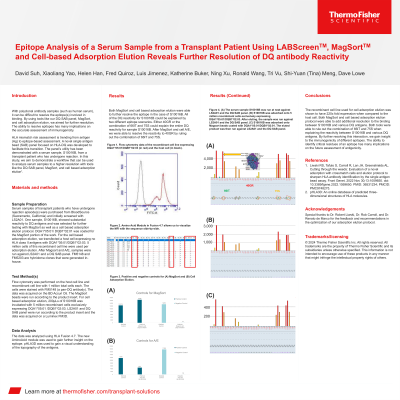Back

(P108) Functional epitope analysis of serum samples from transplant patients using LABScreenTM, MagSortTM, and cell-based adsorption elution reveals a deeper understanding of DQ antibody specificities
Location: Platinum Ballroom

Poster Presenter(s)
Aim: HLA mismatch risk assessment is trending from antigen (Ag) to epitope-based assessment. A DQ single antigen bead (SAB) panel was developed for this purpose. Its utility has been demonstrated with sera samples from transplant patients with rejection episode(s). In this study, we aim to develop a workflow in analyzing clinical samples to a higher resolution than antigens or eplets.
Method: Serum samples from transplant patients who have undergone rejection episode(s) were initially screened with LABScreen. Samples with substantial (>3,000 MFI) anti-DQ reactivity were further tested. HLA Fusion software was used to visualize the data and their anti-DQ reactivity was analyzed with AminoAcid module. Samples with unclear reaction patterns were tested with MagSort and/or adsorption-elution (A/E) with recombinant cell lines expressing single antigens. The eluates were then tested on LABScreen and our novel DQ panel. If multiple functional epitopes are predicted, selected engineered variants (EVs) are employed to resolve the ambiguity.
Results: A total of over 1,000 serum samples from over 500 unique transplant patients were screened at neat with LABScreen. By employing our workflow, functional epitopes have been resolved for samples with ambiguous specificities. In one case, sample S10370C was tested with both Labscreen. All of the DQ reactivity could be explained by two different eplet scenarios (61FT on DQA or 84QL on DQB). After running this sample with our novel DQ panel, the AminoAcid module clearly shows reactivity to novel DQA/DQB pairs such as DQA1*03:01/DQB1*06:01 (MFI: 4030), and antigens without 61F and 64T sharply dip to 0 MFI. MagSort and cell-based A/E both showed that the entire DQ reactivity profile could be pulled out with DQA1*02:01/DQB1*03:03).
Conclusion: Despite a lack of patient history and typing information, we have uncovered additional information on functional epitopes recognized by serum samples based on specificity profiles on SAB panels with broadened HLA-DQ coverage, MagSort, and cell-based A/E. Identification of critical, individual amino acids can be confirmed by comparing reactivity on wildtype vs. EVs. We are continuing this approach on additional samples.
Method: Serum samples from transplant patients who have undergone rejection episode(s) were initially screened with LABScreen. Samples with substantial (>3,000 MFI) anti-DQ reactivity were further tested. HLA Fusion software was used to visualize the data and their anti-DQ reactivity was analyzed with AminoAcid module. Samples with unclear reaction patterns were tested with MagSort and/or adsorption-elution (A/E) with recombinant cell lines expressing single antigens. The eluates were then tested on LABScreen and our novel DQ panel. If multiple functional epitopes are predicted, selected engineered variants (EVs) are employed to resolve the ambiguity.
Results: A total of over 1,000 serum samples from over 500 unique transplant patients were screened at neat with LABScreen. By employing our workflow, functional epitopes have been resolved for samples with ambiguous specificities. In one case, sample S10370C was tested with both Labscreen. All of the DQ reactivity could be explained by two different eplet scenarios (61FT on DQA or 84QL on DQB). After running this sample with our novel DQ panel, the AminoAcid module clearly shows reactivity to novel DQA/DQB pairs such as DQA1*03:01/DQB1*06:01 (MFI: 4030), and antigens without 61F and 64T sharply dip to 0 MFI. MagSort and cell-based A/E both showed that the entire DQ reactivity profile could be pulled out with DQA1*02:01/DQB1*03:03).
Conclusion: Despite a lack of patient history and typing information, we have uncovered additional information on functional epitopes recognized by serum samples based on specificity profiles on SAB panels with broadened HLA-DQ coverage, MagSort, and cell-based A/E. Identification of critical, individual amino acids can be confirmed by comparing reactivity on wildtype vs. EVs. We are continuing this approach on additional samples.

